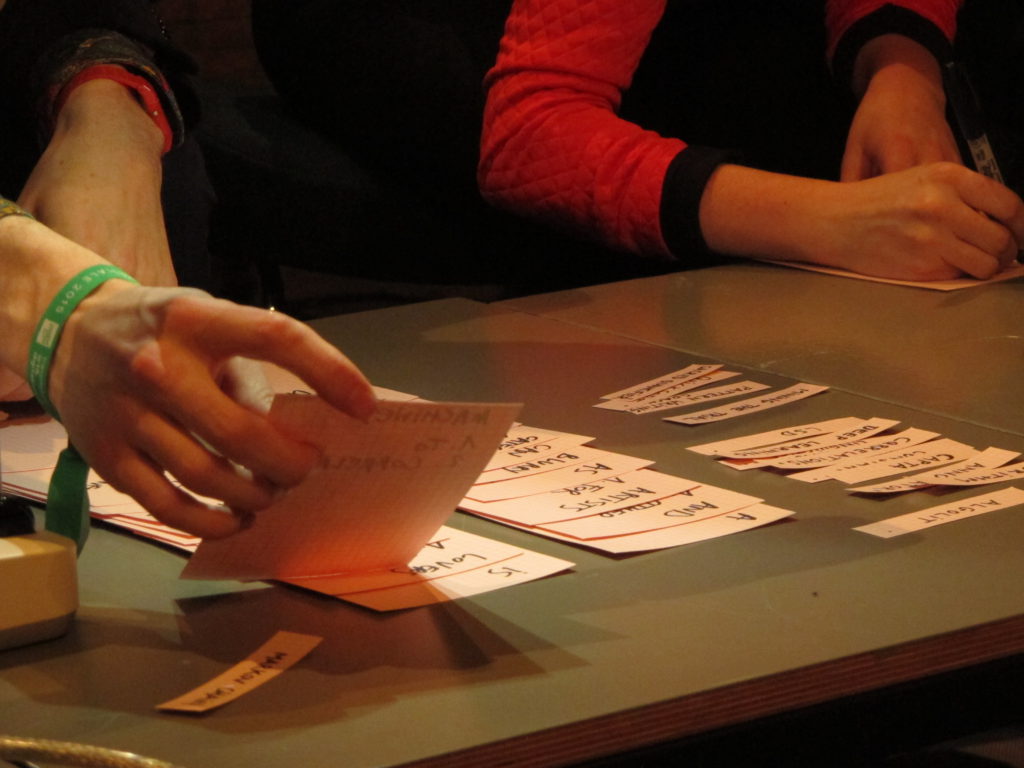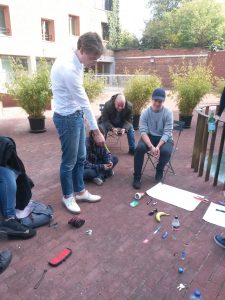De Markov Chain werd ontworpen in 1906 door Andrey Markov, een Russische wiskundige die het leven liet in 1992.
Dit algoritme ligt aan de basis van heel wat softwares die spam genereren.
Het wordt gebruikt voor systemen die een reeks evenementen beschrijven die onderling afhankelijk van elkaar zijn. Wat gebeurt, hangt enkel af van de vorige stap. Daarom worden Markov Chains ook ‘geheugenloos’ genoemd.
Het spel werd ontwikkeld in twee versies, een versie met zinnen en een kaartsysteem (ism Brendan Howell, Catherine Lenoble en Désert Numérique); en een versie met voorwerpen (ism de deelnemers aan de workshop in december 2015 in Consonni, Bilbao: Itziar Olaizola, Emanuel Cantero, Pablo Mendez, Ariadna Chezran, Iñigo Benito, Itziar Markiegi, Josefina Rocco, Andrea Estankona, Mawa Tres (Juan Pablo Orduñez), Maria Ptqk).

Transmediale, Berlijn, jan 2015
With objects:
Play with 4 people minimum
1. Create data to model the Markov Chain algorithm with:
1.1. The players find 3 objects in your bag you all have in common.
1.2. Each object represents a word. A word can be a noun, a verb, a group of words or a punctuation mark. The players agree on one word or a sequence of words for each of the three objects.
1.3. Each player creates a sentence using four personal objects of which at least one object/word is one of the tree common objects/words.
1.4. Each player presents her objects sentence and adds it to the collection in respective order. This collection forms the text with which you will create the Markov Chain model.
2. Create a database using your sentence collection:
2.1. Start with the first object of the first sentence. This is the first key in your database.
2.2. The object following the key is an entry for this key in the database.
2.3. If this entry object does not exist as a key in the database:
2.3.1. Add the object as a key.
2.3.2. Repeat 2.2.
2.4. If this entry object already exists, ignore the object.
2.5. Repeat 2.2. till 2.4. till for all objects of your collection.
2.6. You have now a database with all unique words of your text. The collection of unique words is called the ‘vocabulary’. The database is called the model.
3. You can now use your model to generate new texts:
3.1. The players decide on a rule to define who can start the game.
3.2. The person playing chooses one of the objects.
3.3. A colleague writes the word corresponding to the object on a piece of paper.
3.3. The person playing throws the dice.
3.4. The number n indicated on the dice defines the following object/word of the generated text, the n’th entry of the key in the database.
3.5. The selected object/word becomes the new key, the owner of the object becomes the new player.
3.6. The owner of the object has the right to throw the dice.
3.7. Repeat step 3.3. till 3.6. until you reach a punctuation.
4. Read the sentence!
With sentences and cards:
1. We take a text, for example:
“Cqrrelations read as poetry to statisticians. Can statisticians read poetry with machines?
Cqrrelations is a practise for artists, for datatravellers, statisticians and other lovers of machines to explore a world of blurry categorisations and crummylations.
Machines correlate to dissidents, dissidents correlate to statisticians.”
2. We create a database for this text; each word is an entry and takes the following word as a possible value. The entry for ‘Cqrrelations’ will have two values:
1. read
2. is
3. Once the database is created, we choose a starting word for a new text, for ex. Cqrrelations.
4. We roll the dice, odd numbers will give ‘read’ as the 2nd word of our text; even numbers will give ‘is’ as the 2nd word.
5. We roll the dice again, and choose a word amongst the values of the chosen word. This gives the next word of our sentence.
6. We continue 5 till we arrive at a word with a period (.)
7. We can repeat rule 3 till 6 until we are satisfied with the amount of generated sentences
The output at Transmediale was: “A world of blurry categorisations and other lovers of blurry categorisations and other lovers of blurry categorisations and other lovers of machines. Cqrrelations read poetry to dissidents correlate to machines. Lovers of machines to statisticians.”
Première, Désert Numérique, La Drôme, Frankrijk, juli 2014
ism Brendan Howell, Catherine Lenoble, An Mertens: http://desert.numerique.free.fr//archives/?id=1011&ln=fr

Leave a Reply
You must be logged in to post a comment.